Revenge of the License: Deathtrap Dungeon (1998, Asylum Studios)

Quick show of hands: how many growing up in the 1980s recall Fighting Fantasy game books? These little works of genius were the brainchild of British game designers Steve Jackson and Ian Livingstone, and spawned a whole slew of imitators on both sides of the Atlantic. The books took what was already awesome about the Choose Your Own Adventure novels, the idea of the reader controlling the story and deciding what happened next, then wove in simple game mechanics like combat, tests of luck, and other random elements via reader-provided dice.
The end result was often challenging, sometimes infuriating, but always memorable interactive adventures. While many are considered classics, among the best-known and least-forgiving was Ian Livingstone’s Deathtrap Dungeon, the sixth book in the series. So it’s no surprise that Eidos Interactive, casting about for ideas in a post-Tomb Raider world, turned to the Fighting Fantasy series for inspiration. What could possibly go wrong…?
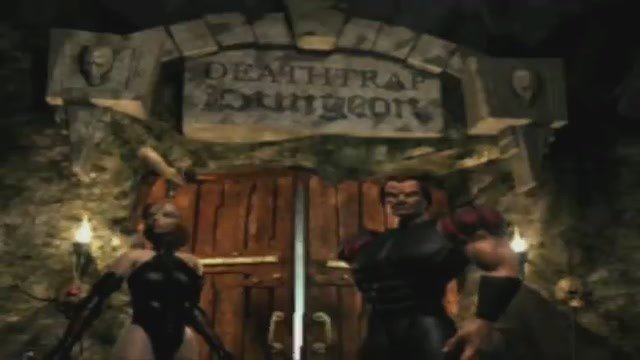
Look, I willingly concede Deathtrap Dungeon is not a "good" game. The controls feel clunkier and more tank-like than Resident Evil, something to which I was unaware a non-Capcom developer could aspire. The camera could rightly be considered a game-spanning boss battle given how often you find yourself fighting against its built-in desire to showcase your ass. It uses a “checkpoint” save system (like the original console versions of Tomb Raider) instead of the more convenient and popular "save anywhere" style. Sometimes you're charged in-game currency for the ability to save, and it turns into a big extortion racket. "Nice game you got goin' there...be a pity if anything happened to it, eh?" Like, what hellspawned fiend approved that part of the design document?
Finally I’m not sure any game into which I dumped so many hours has infuriated me with its ending as completely as Deathtrap Dungeon did. Despite all of its shortcomings, I must admit I “get” the game. While that in no way makes me cooler than the rest of you, it does mean I’m going to text your eyeballs out over the next few paragraphs to explain why Deathtrap Dungeon isn’t as bad as we’ve been told.
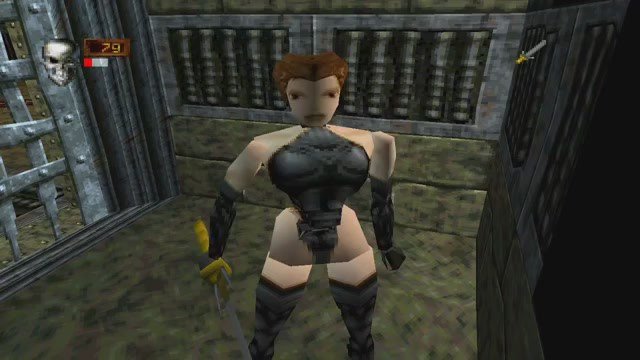
"I'm Red Lotus, obviously no relation to Lara Croft."
Lots of people, myself included, looked at Deathtrap Dungeon up release as a Tomb Raider clone with swords, spells and firearms, because what’s a good dungeon crawl without rocket launchers and flamethrowers? This is fair: it's a 3D, polygon-based world where protagonists Chaindog and Red Lotus fight through a morass of enemies while dodging traps, leaping pits, and collecting goodies. That it was published by Eidos, purveyors of Lara Croft’s exploits, is the proverbial icing on the cake. Rather than viewing Deathtrap Dungeon as a re-skinned TR expansion pack, I’d prefer to look at the game for what it (and the Fighting Fantasy game books in general) truly was: the precursor of some infamous games to come.
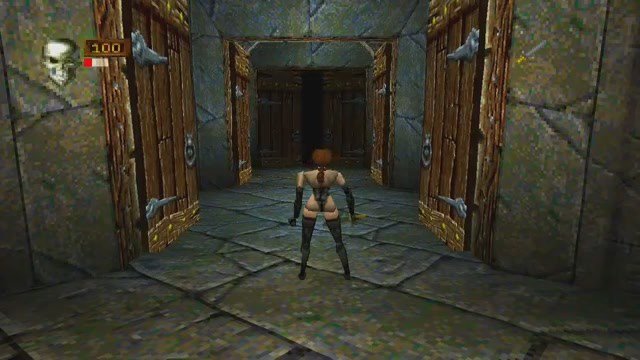
"Come into my parlour," said the spider to the fly...
If you tried honestly playing through a Fighting Fantasy book by rolling dice, and didn’t just cheat your way past all the battles and traps, you know they share design features with video games today. Getting through on your first go is all but impossible unless you are the luckiest bastard this side of the guy who married Natalie Portman. In a Fighting Fantasy book curiosity maims the cat, but only about 70% of the time. It’s that niggling ‘maybe this is one of those 30% bits’ feeling in the back of your mind that causes you to ask, “Should I open the door to investigate that buzzing sound, or should I just keep walking down the corridor?”
Of course you’re going to open the door.
Of course you’re going to investigate the buzzing sound.
Of course you’re going to wander head-first into something that screams ‘TRAP!’ from every angle.
We do it because we need to know. Also because we’ve got our finger marking the page we just came from, so when we’re stung to death by giant tarantula hawk wasps as soon as we open the door, we can Ctrl + Z that shit and pretend it never happened. Fighting Fantasy novels feature a user-controlled game save system. They were meant to be meta-gamed. Getting through them using your prior experiences to inform new decisions was a feature, not a bug.
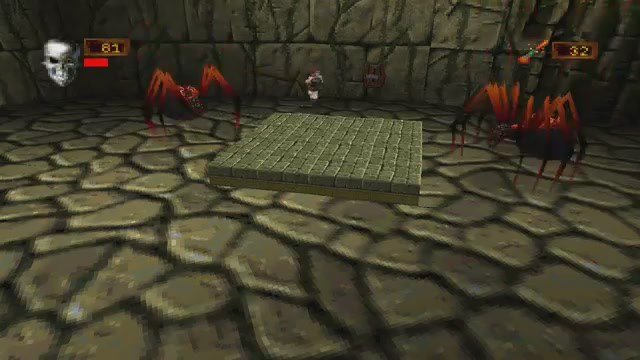
Also not bugs. They're arachnids. Know the difference!
Few video games prior to Deathtrap Dungeon successfully fused these elements together, and none did so anywhere near as maniacally or tongue-in-cheek as this one did. Say what you will about Deathtrap Dungeon's design, you cannot claim the game failed to translate the atmosphere of the Fighting Fantasy book it’s based on perfectly. It’s an insane world, hand-built by designers to slaughter you, mercilessly and repeatedly, with little consistency. There are times when fighting is the only way forward, and times when standing your ground ensures your slaughter. Sometimes flipping a switch saves your life, sometimes doing so consigns you to a lava bath. Even if you’re the most skilled speed runner in the world, it’s impossible to avoid taking a few whacks on the head or suffering a few percentage points of fall damage. Gamers raised on a steady diet of Super Mario Bros. and Myst found this frustrating, and reviewers of the day lambasted Deathtrap Dungeon for being so damnably cruel, not realizing this was exactly the point. Fighting Fantasy always played dirty, and it expected you to do likewise.
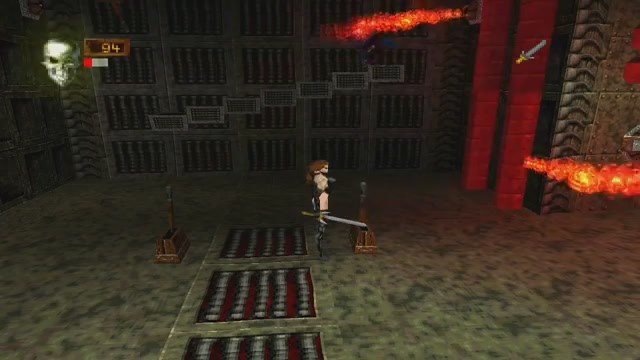
There's an imp being roasted in the upper-right corner.
I recall an interview one magazine held with the folks from Asylum Studios. The magazine editor watched as one of the devs walked him through an early level, showcasing some of the puzzles and traps. At one point the dev comes across a switch on the wall which, if pulled, drops the player into a shaft and activates an incinerator trap at the bottom, and he relates this to the magazine guy. The interviewer asks the developer how a player escapes such a trap if they trigger it, and the dev gleefully replies, “They don’t.” The interviewer walks away feeling less-than-impressed with this take on the game’s design, but I laughed my ass off: that developer understood what Fighting Fantasy was all about.
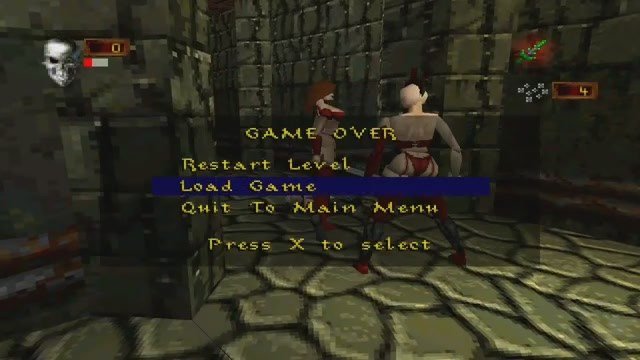
It's basically all about this.
That said, the folks at Asylum weren’t complete sadists. The first level, in fact, features a switch that closes the door and activates fire jets on the walls to roast you…but it will only do so if you’re dumb enough to wander in, ignore the skeleton on the floor right in front of the switch, don’t notice the holes in the wall, and follow the script of, "see switch, flip switch" drilled into you by countless puzzle and platformer games before. If you fall victim to that trap, it’s because you’re not paying attention. If you’re ever not paying attention in Deathtrap Dungeon, the game will cock-slap you until you to apologize. If you want to avoid seeing your insides become your outsides, never get taken in by a mischievous leprechaun, and leave as few things to luck as possible, pluck a different game from your shelf. Deathtrap Dungeon is for people who don't want their games spoon-fed to them in easy-to-digest chunks.
If, on the other hand, the prospect of throwing fireballs at a Tyrannosaurus Rex (technically a Pit Fiend, but we know better) while getting mooned by blue-skinned imps and blocking the knife thrusts of psychotic clowns as you cross a narrow, swinging-blade-trapped causeway above a spiked pit filled with suicide-bombing pigs appeals to you, then come on in, brother. As Smaug told Bilbo, “There’s plenty and to spare.”
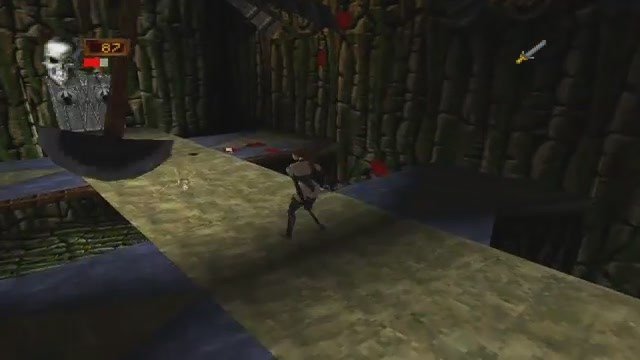
See what I mean?
Nothing I wrote above is the least bit hyperbolic. Deathtrap Dungeon features over forty different enemies, including bosses, and the fighting is as brutal as you could get in the late 90's. Swords hack off arms, legs and heads with gleeful abandon. Explosives reduce targets to bouncing gore blocks. Asylum coded their own splatter engine so blood would slide down walls, drip off ceilings, and coagulate on floors instead of just doing the “put a blood splat sprite on the texture and call it a day” routine you saw in Doom or Duke Nukem 3D. The 3D-accelerated PC version goes the extra mile, with your character model sporting ever more cuts, bruises, gashes, burns, black eyes and wardrobe malfunctions as your heath decreases.
The game also offers up a psychotic number of weapons, gizmos, magical spells, potions and other goodies to collect. The protagonists of Deathtrap Dungeon will have even the least-obsessive role player yelling about encumbrance rules after the third level, to say nothing of the end game where you’re running around with more swords, warhammers, scrolls, potions, charms and guns than a fully-equipped six-person party in a D&D game. They’re even nice enough to give you a limited supply of chalk with which to mark areas within each massive level so you can tell where you’ve been, where traps are, or that vandalism is awesome. How many times have we played Tomb Raider and wished we could do the same? Hell, the PC version and the PS1 version are completely different games, making each one a new experience. Unfortunately none of this was good enough.
With the problem controls, wonky camera, development costs which spiraled out of control as deadlines came and went like visitors to a struggling whorehouse, and an ending that not only makes no sense but also fails to reward the player with anything promised in the introductory sequence, Deathtrap Dungeon did what it set out to do…but only barely. Asylum Studios shut down in the wake of this game’s release, and it’s obvious why, but the proof gamers will go nuts over something that so cheerfully seeks to obliterate them at every turn can be seen in From Software’s Demon’s Souls.
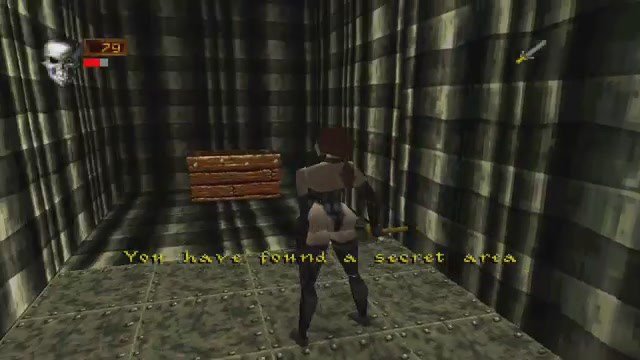
Could the secret area be trapped? Only one way to find out...
Demon’s Souls and the companion Dark Souls titles prove gamers, when given the option of a well-coded title that has no qualms about squashing the players on a whim, will chant, “Bring it on!” in droves. Deathtrap Dungeon is the obvious precursor to games like I Wanna Be The Guy: The Movie: The Game, Super Meat Boy, and every other ridiculously hard title where death is just part of the in-game tutorial. Played with this mindset, it’s easy to see what Deathtrap Dungeon did right and I suspect if it was remastered in HD with tighter controls that utilize the analog sticks, it would sell like gangbusters. So come on, Square-Enix. Ian Livingstone sits as Lifetime President of Eidos, a company you own. Dig into the archives, dodge the traps, and bring Deathtrap Dungeon back into the light of day so a whole new generation can feel the pain. Just, for the love of God, give us an ending that makes sense this time, pretty please with Nutella on top.
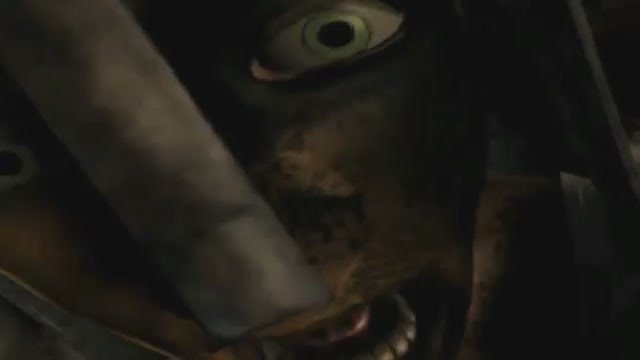
Your face upon completing Deathtrap Dungeon.
I penned this column for Retro Gaming Magazine](http://retrogamingmagazine.com/2015/04/12/revenge-license-deathtrap-dungeon/) in April 2015. It appears here in a slightly edited and modified format from the original.
Your post was upvoted by the @archdruid gaming curation team in partnership with @curie to support spreading the rewards to great content. Join the Archdruid Gaming Community at https://discord.gg/nAUkxws. Good Game, Well Played!
Hot dang, thanks, @archdruid! :D